Even if you’re not in the path of annularity during the June 10th solar eclipse, get ready for a sunrise spectacle.
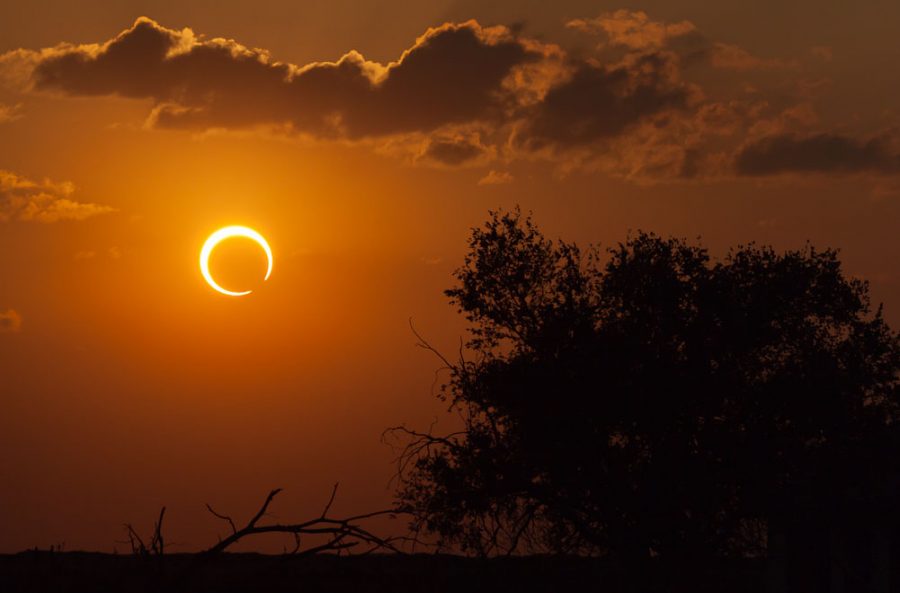
Kevin Baird
The dance goes on. Two weeks after May's total lunar eclipse, the Sun, Moon and Earth align again on Thursday, June 10th. This time, the Moon glides between the Earth and the Sun to grace the morning sky with an annular eclipse. The eclipse is central but not total because the Moon is near apogee, its most distant point from Earth. Its apparent diameter of 29.5′ will be two arcminutes shy of completely covering the Sun, leaving an arcminute-wide "ring of fire" at maximum eclipse.
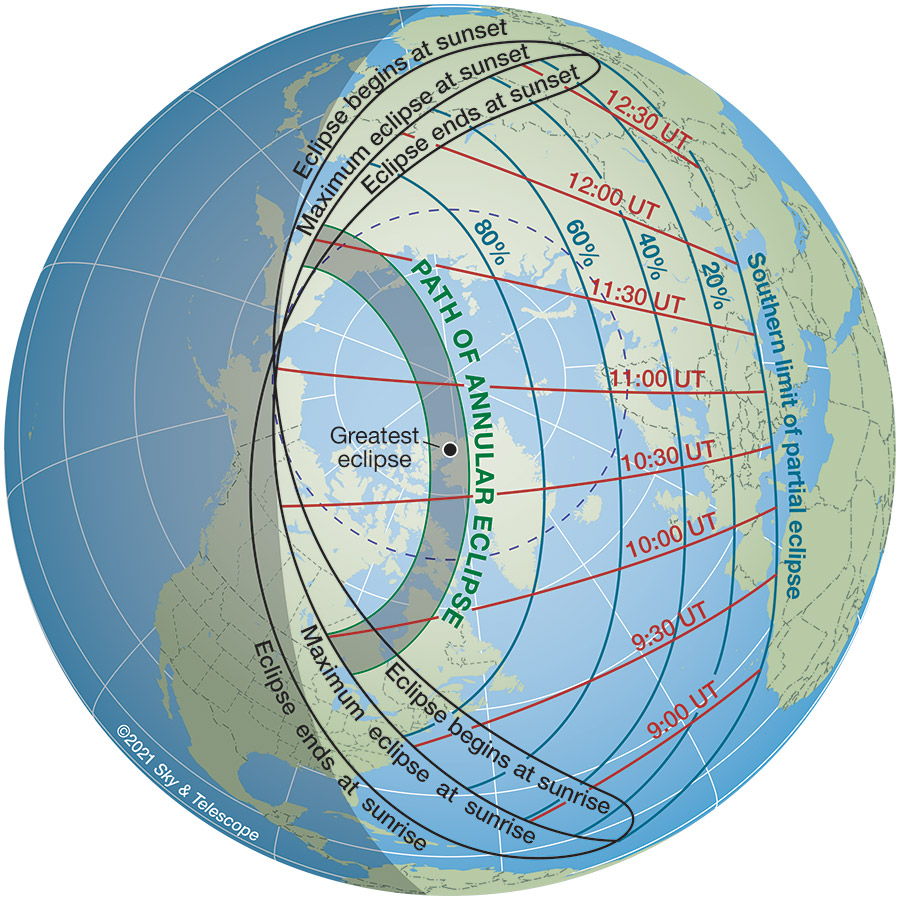
Sky & Telescope
The Moon's shadow strikes the Earth at an oblique angle during the upcoming eclipse, cutting a broad path that starts along the north shore of Lake Superior in Ontario and passes over Hudson Bay and northwestern Greenland before moving on to Russia. It even includes the North Pole, where 2 minutes 36 seconds of annularity will interrupt more than 2 ½ months of continuous daylight. Anyone living within this expansive strip — and there aren't many! — will see a ring or annulus of sunlight at maximum eclipse.
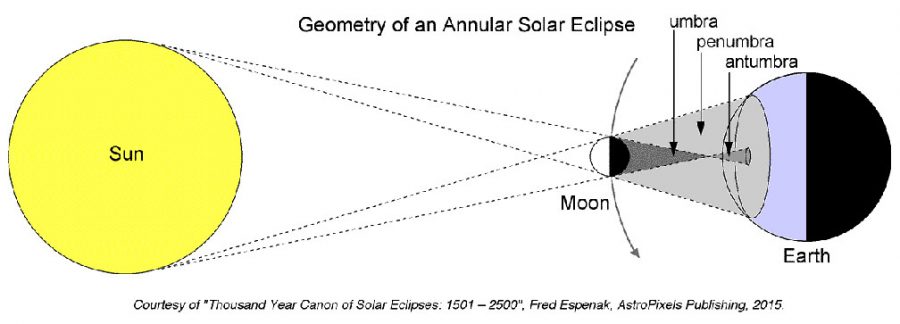
Eclipse Predictions by Fred Espenak, www.EclipseWise.com
COVID-19 Hurdles
Eclipse enthusiasts who hoped to drive north for the event won't be able to cross into Canada due to COVID-19 restrictions in place until at least June 21st. One way around this is to fly into the eclipse path. To that end Sky & Telescope has chartered a flight into southern Ontario on the big day. There are still a few seats left as of this writing. Click here for more information.
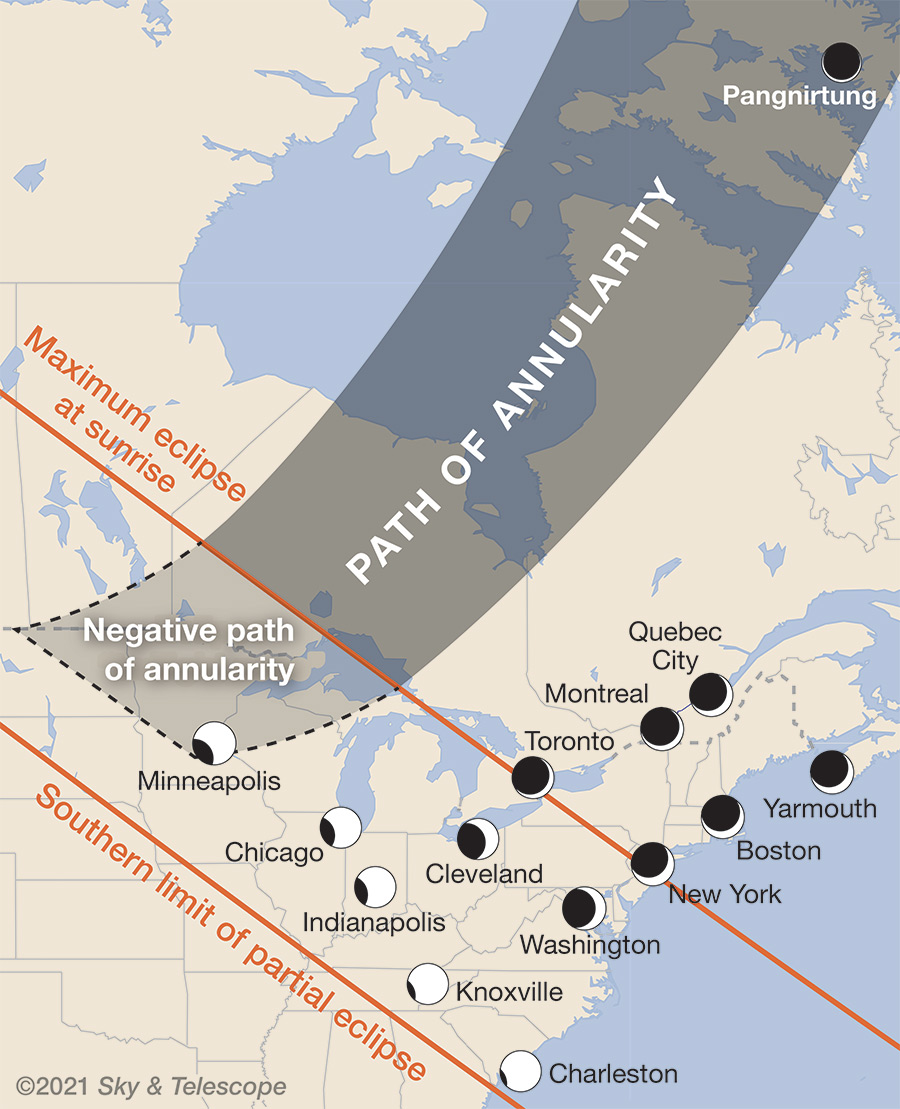
Gregg Dinderman / S&T
Meanwhile, a large swath of the eastern U.S. and Canada along with observers across much of Europe and Asia will witness the eclipse's partial phases. For millions of Americans the Sun will rise steeped in a deep partial eclipse. It goes without saying you'll need an unobstructed northeastern horizon to see it best. If possible, try to watch the eclipse from a lake where the blazing crescent and its glitter path should be nothing short of spectacular. Check out this video made on May 10, 2013, to see just how amazing a sunrise annular eclipse can be.
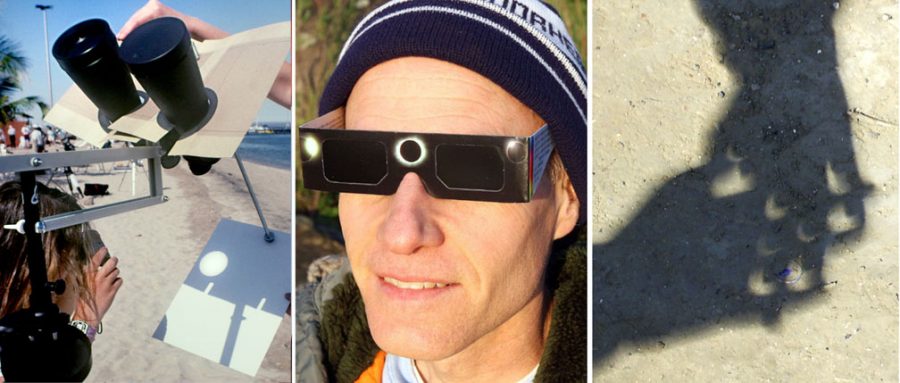
Bob King (left, center) and Sealle / CC BY-SA 4.0 (right)
Many of us will be tempted to look at the rising Sun at the horizon where haze often attenuates its light. Be careful. A momentary glance might be OK, but never stare at the Sun even for a second. Infrared light can cook your retinas and permanently damage your vision. Keep eclipse glasses at the ready. If you purchased a pair for the 2017 total eclipse, inspect them for wear and tear. As long as they're not scratched up or full of pinholes you can reuse them for this eclipse. If you need a fresh pair, try one of these or go to Amazon, which has a similar selection. Make sure they are ISO / CE certified. Another good option is an inexpensive #14 welder's glass from a welding supplier in your city or region.
Do-it-yourself eclipse predictions
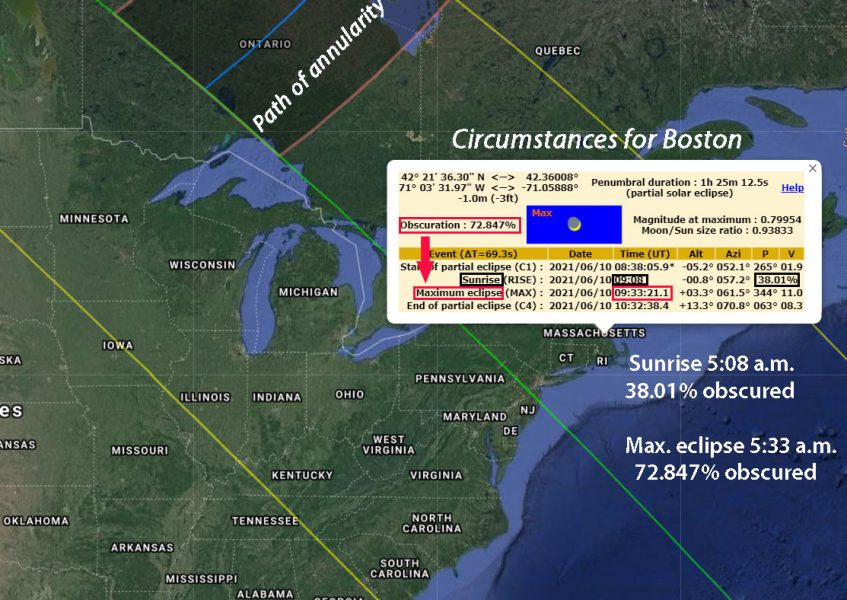
Xavier M. Jubier
The table (below) lists eclipse circumstances for 20 cities, but you can easily get all the details of your local circumstances at Xavier Jubier's Interactive Solar Eclipse Map. Zoom in to the map and click on where you plan to watch the eclipse. A box will pop up that includes the time of sunrise and the percent of the Sun's disk obscured by the Moon. Note that times are in Universal Time (UT). To convert to EDT, subtract 4 hours; 5 hours for CDT; 6 for MDT; and 7 for PDT. For a full explanation of each line in the pop-up box, click the blue Help link.
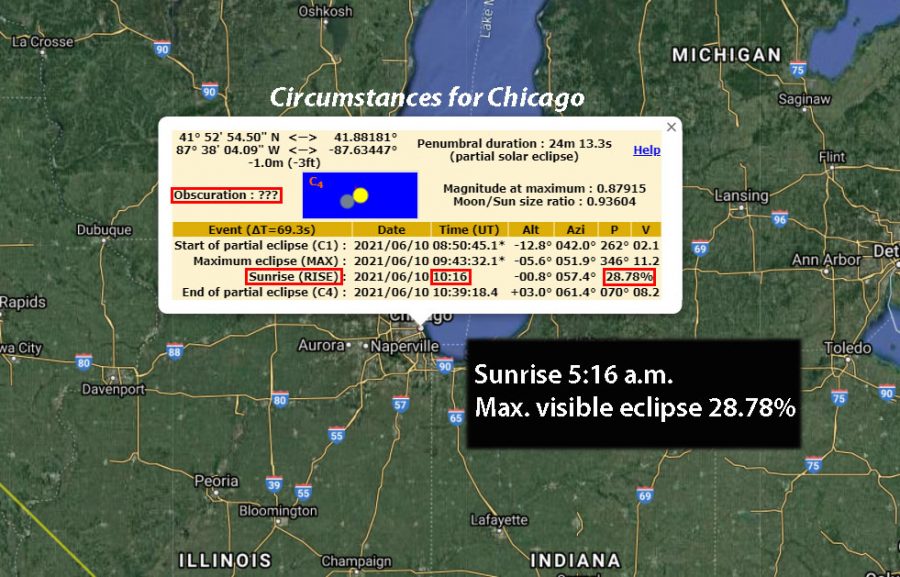
Xavier M. Jubier
I'm especially interested in this eclipse because I live in the negative path of annularity, where the Sun will be in annular eclipse shortly before sunrise. I'm envisioning a bizarre twilight that begins normally but then stalls as annularity approaches before resuming its normal (though perhaps muted) progression just before sunrise. The quality of the light during this time should be fascinating to watch as well as any effects the solar annulus might have on clouds along the eastern horizon.
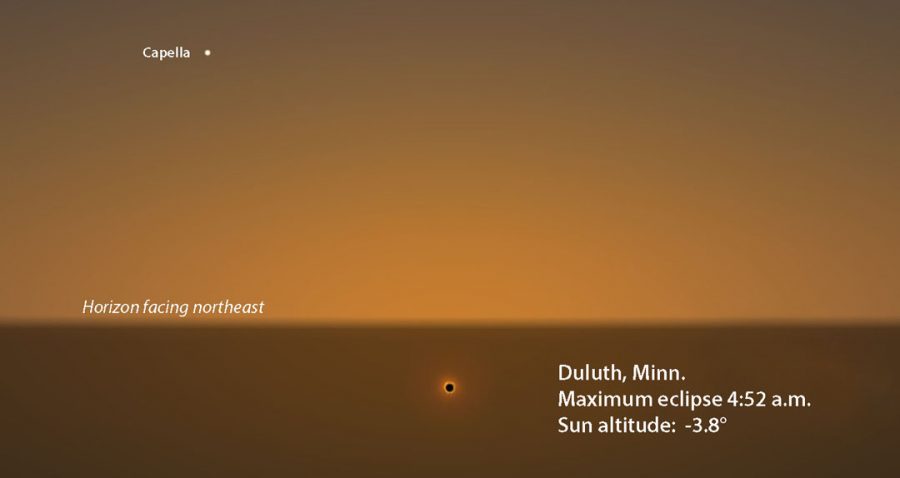
Stellarium

Stellarium
From many central U.S. and southern Canada locations the maximum obscuration occurs before sunrise, so the best views will be just as the Sun comes up with the Moon's egress underway. Locations farther east will see maximum eclipse after sunrise. The diagrams show the percentage obscuration, which is the fraction of the Sun's area covered by the Moon. Charleston, South Carolina, is the largest and southernmost U.S. city to see a partial eclipse, with the Sun just 4.6% covered when it fully clears the horizon. If more than half the Sun is covered from your location be alert for changes in the quality of the light, falling temperatures and unusual animal and insect behavior.
Circumstances around the planet
| City | Sunrise/sunset | Max. eclipse | Obscuration | Alt. | End of eclipse |
| Fairbanks, AK | 3:09 a.m. | 2:50 a.m. | 50.1% at sunrise | –0.3° | 3:44 a.m. |
| Thunder Bay, ON | 5:56 a.m. | 5:53 a.m. | 85.4% at sunrise | –0.3° | 6:50 a.m. |
| Chicago, IL | 5:16 a.m. | 4:44 a.m. | 28.8% at sunrise | –0.3° | 5:39 a.m. |
| Detroit, MI | 5:56 a.m. | 5:41 a.m. | 60.6% at sunrise | –0.3° | 6:38 a.m. |
| Ottawa, ON | — | 5:40 a.m. | 80.1% | 3.2° | 6:40 a.m. |
| Quebec City, PQ | — | 5:40 a.m. | 78.9% | 6.5° | 6:41 a.m. |
| Pittsburgh, PA | 5:50 a.m. | 5:36 a.m. | 60.7% at sunrise | –0.3° | 6:33 a.m. |
| Charlotte, NC | 6:09 a.m. | 5:31 a.m. | 16.8% at sunrise | –0.3° | 6:26 a.m. |
| New York, NY | — | 5:33 a.m. | 72.5% | 1° | 6:31 a.m. |
| Cambridge, MA | — | 5:33 a.m. | 72.9% | 3.5° | 6:33 a.m. |
| Reykjavik, IS | — | 10:17 a.m. | 60.5% | 38.5° | 11:33 a.m. |
| Dublin, IE | — | 11:09 a.m. | 28.5% | 50.3° | 12:22 p.m. |
| London, UK | — | 11:13 a.m. | 20.0% | 54.9° | 12:23 p.m. |
| Madrid, ES | — | 11:43 a.m. | 4.8% | 53.9° | 12:29 p.m. |
| Venice, IT | — | 12:26 p.m. | 2.2% | 65.9° | 1:05 p.m. |
| Vienna, AT | — | 12:40 p.m. | 4.4% | 64.7° | 1:28 p.m. |
| Helsinki, FI | — | 2:04 p.m. | 26.8% | 52.1° | 3:15 p.m. |
| Moscow, RU | — | 2:26 p.m. | 15.7% | 50.8° | 3:28 p.m. |
| Beijing, CN | 7:43 p.m. | 8:19 p.m. | 7.6% at sunset | –0.3° | — |
Source: Xavier M. Jubier
For now, I'm aware of two livestreams (below) for watching the eclipse online. If you hear of others, please let me know, and I'll add them. Check here for solar eclipse photo tips, and remember to share the event with family and friends. It feels good to finally come out of our COVID-19 shells into the sunshine.
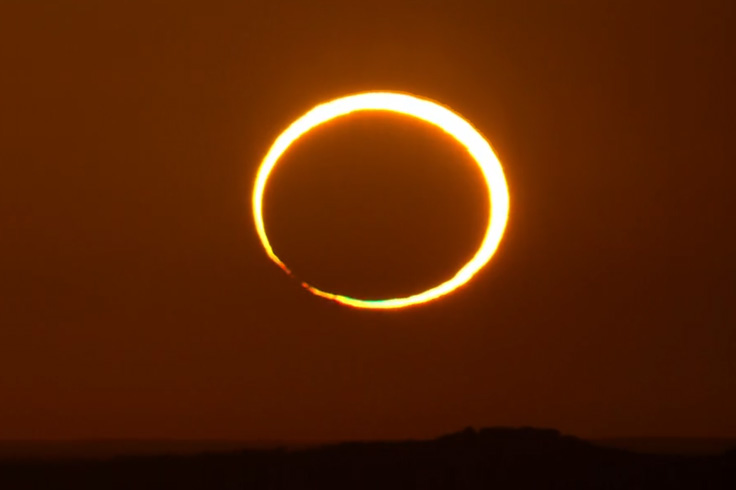
Geoff Sims & Colin Legg
Livestreaming options:
Timeanddate.com YouTube starts June 10th, 3 a.m. CDT (8:00 UT)
CosmoSapiens YouTube, starts June 10th, 2 a.m. CDT (7:00 UT)
Virtual Telescope with Gianluca Masi, starts June 10th, 4:30 a.m. CDT (9:30 UT)
If you're interested in reading more about this and other celestial events this month click here to purchase a copy of the June 2021 issue of Sky & Telescope.
 14
14









Comments
Anthony Barreiro
June 3, 2021 at 10:32 pm
I would love to hear from people who observe this solar eclipse before sunrise. The world is full of unimagined wonders.
You must be logged in to post a comment.
Bob KingPost Author
June 4, 2021 at 2:58 pm
Anthony,
Thank you for inviting observers to share what could be unique observations of this most interesting eclipse.
You must be logged in to post a comment.
Yaron Sheffer
June 7, 2021 at 12:18 pm
Anthony, you are a riot!
If I read the map correctly, good places from which to watch this eclipse can be found north of the North Pole.
You must be logged in to post a comment.
Michael
June 4, 2021 at 6:14 pm
Another eclipse site (mine): https://heywhatsthat.com/eclipse
Pro tip: It lets you see the eclipse before sunrise! But if you need to know if the sun has risen, use the url https://heywhatsthat.com/eclipse&horizon=1 and zoom out a bit on the right-hand window (the sky view) until you see a line representing the horizon; hash marks are below the horizon.
You must be logged in to post a comment.
Michael
June 4, 2021 at 6:16 pm
That second URL should read https://heywhatsthat.com/eclipse?horizon=1
(the first URL is fine)
You must be logged in to post a comment.
misha17
June 4, 2021 at 9:16 pm
I'm trying to picture what it would be like near the end of the path of annularity. It's just about on the Arctic Circle, and the eclipse occurs so close to the Summer Solstice that the sun would just skim the northern horizon in the area where the "Eclipse Ends At Sunset".
I would imagine the eclipse begins with the sun low on the horizon (probably around 10pm local time, if that counts as "late afternoon"); the eclipse progresses; annularity occurs; the moon moves "downward" toward the horizon as it starts to clear the suns disk; there is finally only a small "bite" on the sun just above the horizon; then either the "bite" leaves the sun as it skims the horizon, or the sun briefly sets (maybe with still a small "nibble"), then quickly rises uneclipsed.
Does that scenario sound right?
You must be logged in to post a comment.
misha17
June 4, 2021 at 9:29 pm
Oops, I think I got the last part backwards. Eclipse begins on the western edge of the sun, and moves eastward across the sun as the sun moves westward in the sky.
After annularity the moon is moving away on the eastern edge of the sun as the western edge of the sun moves towards the horizon. Near the end the sun is at or just above the horizon, and there is small "bite" at the top of the sun away from the horizon. Either the "bite" completely leaves the sun as the sun skims the horizon, or the sun briefly sets with a bite, then quickly rises without the bite.
You must be logged in to post a comment.
BruceZ
June 6, 2021 at 8:01 pm
How does one take the types of photos in this article and even the linked video without damaging the camera? I think if a solar filter of the type suitable for viewing eclipses is used, all that will appear is the sun. Yet the examples show clouds, trees, mountains, water, etc.
You must be logged in to post a comment.
Yaron Sheffer
June 7, 2021 at 12:31 pm
The camera is less prone to damage than our vision, me think. In addition, these are very short exposures. Am guessing also that perhaps not-so-dark filters are used. Finally, if I'm wrong, then solar photography ends up as a very expensive hobby 😐
You must be logged in to post a comment.
Rob_L.
June 9, 2021 at 12:04 pm
Thanks for such an informative and in-depth article of the upcoming eclipse.
I'm just a novice stargazzer but have always been fascinated with eclipses and Sun & Moon rises. Sky & Telescope is my confident "go to" for such events. Thanks again!
You must be logged in to post a comment.
Bob KingPost Author
June 10, 2021 at 5:56 pm
You're welcome, Rob!
You must be logged in to post a comment.
Rod
June 10, 2021 at 8:56 am
Bob King et al. I did enjoy viewing some of this solar eclipse at sunrise this morning. Here is my stargazing log report 🙂 [Observed 0530-0615 EDT/0930 UT - 1015 UT. New Moon 10-Jun-2021 1053 UT. Sunrise at my location this morning 0541 EDT/0941 UT. I was able to view this partial solar eclipse today using 32-mm plossl eyepiece with glass, white light solar filter at 31x using the 90-mm refractor telescope. The Sun was high enough by 0552 EDT/0952 UT, just above a distant tree line that the celestial event was visible in my telescope. The black, silhouette shape of the Moon very distinct and obvious as the Sun rose. Altocumulus cloud bands in the distance moved by making for an ethereal experience and view. There was some unevenness or slight bumps along the lunar disk visible too at 31x. Sunspots AR2832 and AR2829 reported this morning at spaceweather.com but difficult because of altocumulus bands moving by the view, the Moon’s dark shape much easier to see. After 0613 EDT/1013 UT, more altocumulus bands moved in covering the Sun completely. Skies became mostly cloudy at my location, so I packed up and enjoyed breakfast and morning coffee. While the skies were partly cloudy at sunrise, I was able to enjoy some of this solar eclipse event. The 17-year cicada were out and getting louder. I viewed from a large horse farm field with good view of Eastern sky. A distant tree line did not interfere much with the early morning observations as the Sun and Moon rose above the trees near 0552 EDT. NWS EMI winds aloft 12000, 030/06 knots and 18000, 350/06 knots reported. Surface temperature at my location 21C and surface winds 320/04 knots, humidity near 95% so some ground fog too in the pastures. The telescope true FOV ~ 96 arcminute at 31x, The Sun’s angular size ~ 31.5 arcminute, the Moon’s angular size ~ 29.7 arcminute.]
You must be logged in to post a comment.
Bob KingPost Author
June 10, 2021 at 5:56 pm
Hi Rod,
The readers and I really appreciate your detailed, on-the-spot reports. Thank you! And I'm glad you saw it.
You must be logged in to post a comment.
Andrew James
June 10, 2021 at 7:57 pm
Wow! Kevin Baird's May 20, 2012 picture is wonderfully beautiful.
Also. I'm surprised no one here has cottoned onto observing Baily's beads along the cusps, if you go near the path's edge of annularity. Whilst seeing a perfect defined ring is aesthetically nice, it is just a moment, where as the beads can be up to fifteen minutes of fun. The acceleration and the deceleration of beads either before or after mid-eclipse is breathtaking. [Get a Watts profile, and you see which bumps of the Moon relate to the beads you see.]
Enjoyed the eclipse comments here, especially when I'm not able to leave my own country easily due to COVID.
You must be logged in to post a comment.
You must be logged in to post a comment.